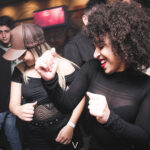Have you ever heard the phrase “Dance The Light Fantastic” and wondered about its meaning? Perhaps the movie Mary Poppins Returns brought to mind whimsical images of chimney sweeps dancing across rooftops. While that captures some of the phrase’s charm, the true story behind “dance the light fantastic” is a fascinating journey through literature, language, and the evolution of an idiom. This expression, synonymous with joyful and nimble dancing, has a rich history that stretches back centuries, revealing how words can transform and take on new life.
The origins of this delightful phrase can be traced to the renowned English poet John Milton, best known for his epic poem Paradise Lost. In 1645, Milton penned a lesser-known poem titled “L’Allegro” (meaning “The Happy Man”), where he first used a version of our idiom. Invoking Euphrosyne, one of the three Graces in Greek mythology—goddesses of charm, beauty, and creativity—Milton urged her to “Come and trip it, as ye go / On the light, fantastic toe.”
Alt: Euphrosyne, a Grace from Greek mythology, depicted in a classical style artwork, dancing lightly on her toes, embodying the essence of ‘dance the light fantastic’.
In this original context, “trip the light fantastic toe” wasn’t yet the idiom we know today. It was a literal description, drawing on the Renaissance-era phrase “tripping on the toe,” which vividly portrayed agile and delicate dance movements. Shakespeare himself used this imagery in The Tempest (1610-11), where Ariel, the spirit servant, promises to lead his fellow spirits “Each one, tripping on his toe.” Milton’s genius was in adding the adjectives “light” and “fantastic” to “toe,” amplifying the image of graceful, elaborate footwork. His phrasing resonated with literary figures like Jonathan Swift, the author of Gulliver’s Travels, who in 1735 echoed Milton’s line in a poem: “See the Belle flutter with the sprightly Beau! / They trip it on the light, fantastic Toe!”
However, the idiom’s journey took a turn as it crossed the Atlantic. Somewhere along the way, particularly in America, the word “toe” gracefully exited the expression, giving us the more concise and familiar “trip the light fantastic.” This streamlined version is what most English speakers recognize today when referring to dancing with joy and exuberance.
Pinpointing the exact moment this transformation occurred is challenging, but popular culture provides clues. The late 19th-century song “The Sidewalks of New York,” with its catchy lyrics “Boys and Girls together / Me and Mamie O’Rourke / Tripped the light fantastic / On the sidewalks of New York,” is often credited with popularizing this shortened form. From there, the phrase took flight, appearing in diverse contexts from a 1907 edition of The United States Army and Navy Journal to Nella Larsen’s 1929 novel Passing. In Passing, set during the vibrant Harlem Renaissance, a character observes a racially mixed dance floor, noting, “Not having tripped the light with any of the males, I am unable to argue the point.” This demonstrates the phrase’s growing use in describing social dancing and lively movement.
Alt: A lively black and white photograph capturing people joyfully dancing on the sidewalks of New York City, embodying the energetic spirit of ‘dance the light fantastic’ in an urban setting.
But the evolution didn’t stop there. By the 1930s, popular culture began to further morph the idiom into trip the light fandango. This version gained significant traction with Procol Harum’s 1967 hit song “A Whiter Shade of Pale,” which includes the enigmatic lyrics, “We skipped the light fandango / Turned cartwheels ‘cross the floor.” Adding “fandango,” a spirited Spanish dance, injected a new layer of meaning, associating the phrase with a specific type of energetic and rhythmic movement.
Stephen Sondheim, the legendary musical theatre composer, further played with the phrase in his 1973 musical A Little Night Music. In the upbeat song “The Miller’s Son,” he used variations like “trip the light fandango” and “pitch the quick fantastic.” Interestingly, Sondheim was reportedly unaware of Milton’s original phrase, highlighting how idioms can evolve and be reinterpreted over time, sometimes losing their direct connection to their origins. The fandango itself is a vibrant Spanish dance form with historical roots, so to “skip” or “trip” a fandango literally means to perform this lively dance.
Alt: A vivid painting depicting a couple energetically dancing the fandango, a Spanish dance characterized by its lively rhythm and passionate movements, visually representing ‘dance the light fandango’.
The linguistic journey of “dance the light fantastic” has led some, like Noam Chomsky, to call it a “syntactically ill-formed idiom.” Its structure and meaning have shifted and expanded so much that the original literal image of dancing on light toes has become somewhat obscured. Whether it evokes images of a Spanish fandango or simply the feeling of weightless, joyful movement, “dance the light fantastic” remains a vibrant and enduring idiom. From its literary beginnings in 17th-century England to its modern-day usage, the phrase has indeed danced its way through time, as blithely and fantastically as a nimble dancer taking to the floor. So, the next time you hear “dance the light fantastic,” remember its rich and evolving history – and maybe even be inspired to trip a little light fantastic yourself!

